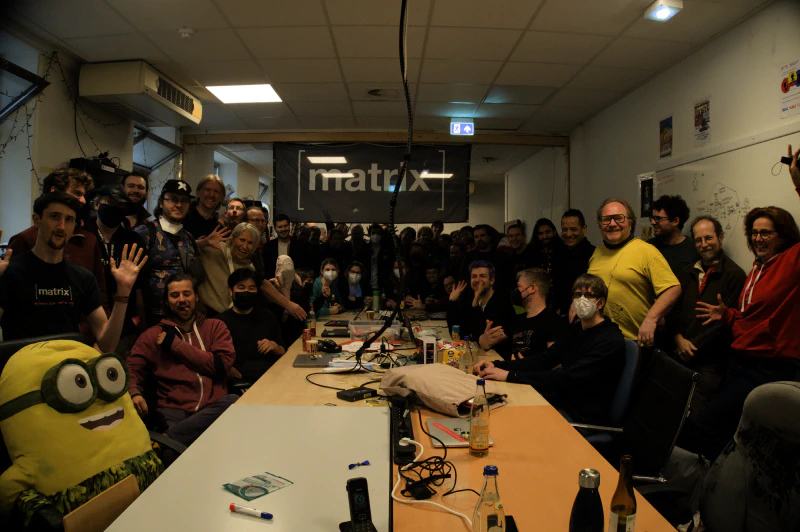Posted
on
in
Travel, Conferences
• 1751 words
• 9 minute read
Tags:
FOSDEM 2025, Matrix, HSBXL, Go (Programming Language), Brussels, Belgium
For the third year in a row, I attended FOSDEM, a Free and Open Source Software conference. I enjoyed the previous two years, and Automattic paid for me to attend, so I decided to make the hop across the pond to attend again. FOSDEM is one of the main gatherings of the Matrix community every year (probably second only to the Matrix Conference), and there is also a sizeable Go presence at the conference as well.
This year, both Brad and Tulir attended from Beeper, and even more from the wider Automattic company.
Matrix Community Meetup

On the Friday before FOSDEM, the Matrix community once again hosted a community meetup at HSBXL. HSBXL has moved since last year to a new location that is a much nicer space. Probably nearly of hundred people were in attendance including prominent members of the community such as Matthew and Greg Sutcliffe (the Matrix Governing Board Chair). Tulir and I headed over in the early afternoon and by the time we arrived, the meetup was in full-swing. My friends Sam and Aiden from Colorado also attended.
I had good conversations with many community members throughout the afternoon and evening. Yan and Kim once again did a fantastic job organizing the meetup as a barcamp with an ad-hoc schedule based on the interests of the people in attendance.
Some of the highlights of the meetup were:
- Speaking to Kegan about the interesting work that he is doing to change the way that federation works in Matrix, and the tooling that he is working on to test federation.
- I met Greg Sutcliffe in-person for the first time. Greg is the Chair of the Matrix Governing Board and is working to build the infrastructure necessary for a stable and effective Board.
- I was able to speak with many regulars at Matrix events such as Kim, Yan, Ben, Asbjørn, Bram, and Nico who I have had the pleasure of interacting with at many previous events. I was also able to meet new entrants into the community such as an individual from Canada who also made the hop across the pond to attend FOSDEM.
- I spoke extensively with Florian about the cool WebRTC work that Element is doing with Element Call, and I met Robin and Timo who on the team pushing that work forward.
- Brad, Tulir, and I spoke with Erik about the interesting work that Element is doing with Synapse Pro to optimize Matrix for large deployments.
- During one of the barcamp sessions, I spoke with a few other homeserver administrators about the challenges they face maintaining a fast and reliable homeserver.
The meetup still hadn’t disbursed well into the evening, and considering I was still somewhat tired from travel and the next day would be a full one, I decided to call it a night.
Go Dev Room
On Saturday, I made my way in a packed tram car to the Université libre de Bruxelles (ULB) to attend the entirely full Go dev room. Tulir arrived a few minutes after me, and we settled in for the talks. The first talk was by Maartje about the state of Go and highlighted the new features we got in the last year. A few highlights are:
- I think that the biggest change since last year is the rangefunc changes where you can define custom iterators. At Beeper, we support the latest two Go versions, and with the recent release of Go 1.24, we can now use that functionality in our projects since it was stabilized in Go 1.23.
- In Go 1.24, we get
debug.ReadBuildInfo()which will provide a way to get the git commit hash and tag for the build which is something that a lot of people do manually with build tags right now. - I’m excited about
go toolwhich allows you to specify tools ingo.mod. This will be especially useful for things likestaticcheckas I will no longer need to install it user-wide, and instead will be able to have a specific version specified on a per-project basis. - In Go 1.24,
crypto/hkdfis being moved from/x/cryptoand being stabilized in thecryptomodule. - In Go 1.24 we get a new
os.RootPathfunction which provides a safe way to expose the filesystem without worrying about escaping using../. - In Go 1.24 there is a new
omitzerooption for JSON encoding which sounds very useful. At Beeper, we often have to make fields pointers just so they can be set toniland omitted usingomitempty. Thisomitzerooption sounds like it will fix this issue.
The next talk was about the internals of Go generics. Anton described how various languages have implemented generics and how Go chose a hybrid approach. The two main camps are stencilling (which is what C++ does), and dictionaries. With stencilling, a new version of the generic function is created for every type that the generic function is called with. With dictionaries, a struct containing the type-specific operations of the generic function is created and passed into a single generic implementation. Go chose a middle route, where there is stencilling based on garbage collection (GC) shape, but within a given GC shape, dictionaries are used.
The morning continued with deep dives into Go internals with a talk about Swiss maps in Go. Swiss maps are so called because they use Closed Hashing which is abbreviated CH which is also the country code of Switzerland. (It also helps that the majority of the team working on this are based in Zurich.) I didn’t fully understand how it all worked, but the things that I gathered were:
- Given a hash, there are three levels of associativity. The first 2 bits of the hash determine which entry in the directory should be used. The middle 55 bits (modulo the number of buckets) are used to determine which bucket the hash belongs in, and the last 7 bits are stored in a metadata array to determine which element in the bucket has a matching hash.
- When trying to determine if a key matches, every element in the metadata array must be compared to the last 7 bits of the hash. This operation can be done in parallel using Single Instruction, Multiple Data (SIMD) operations.
Unfortunately, in some real-world tests it appears that Swiss maps don’t provide significant performance improvements.
An interesting tidbit that was mentioned is that Go’s maps have never been guaranteed to iterate in the same order. Although the previous implementation could provide a stable iteration order, a random seed was added so that developers would not rely on that fact. This allows the Go team to change the way that iteration works without breaking any (even implicit) language guarantees.
Finding More Matrix Folks
The next two talks were not as interesting and my brain was getting overloaded, so I don’t remember much about those talks. I was also getting hungry by this point, and so I made my way out to the food trucks that are brought in every year to feed the masses of nerds attending the conference. I got some Penne Bolognese and after eating it, I headed over to the Matrix booth in building K. I walked around some of the other booths as well, and collected some stickers. I caught up with some other Matrix community members congregating around the booth.
Eventually, Tulir and I decided that it was time for waffles. We went back to the food trucks where there is a Belgian waffle truck which serves chocolate-covered waffles with whipped cream. It was very good.
After spending a little more time talking to people at the Matrix stand, I headed back to the hotel for a rest.
Later that evening, Tulir, Brad and his fiancé Jane, and myself went to dinner at their hotel restaurant. The food was good, but the service was initially slow as it took quite a while for them to bring us a menu. My steak was definitely worth the wait, though.
After dinner, Brad, Tulir and myself walked downtown to meet up with some Element folks at a bar. I had interesting conversations about a variety of topics with Neil, Rich, Eric, Will, and others. I enjoyed speaking with all of them, but I think the highlight for me was my discussion with Neil. We discussed how the Governing Board can help illuminate blind-spots that Element has, and how Element can help the Governing Board understand the broader context of the ecosystem and the difficulties faced by Matrix.org.
Matrix Booth and Devroom
On Sunday, I volunteered at the Matrix stand during the morning. It was fun talking to the people who wandered by the Matrix stand. Some were interested in learning more about Matrix, while others were already users merely in search of cool swag and stickers.
In the afternoon, I went to the Matrix devroom. I especially enjoyed the Matrix State of the Union talk. It was cool to see Timo present some of the work he has been doing with the Rust SDK. I also enjoyed the demo of the work that Kegan is doing to test federation. Another highlight was Erik’s talk about the state of Synapse and the work they are doing to improve it both for community use-cases and large-scale deployments in places like government. It was also fun to see Kevin’s presentation about Robrix which is a new Matrix client developed by Futurewei.
During the afternoon, some other Automattic employees who were attending the conference messaged and we met with them briefly. It was fun to see other people from the company in-person!
After the dev room, I hung out around the Matrix boot for a while, and then Tulir, Kim, Sam, Aiden, and myself went to get dinner. We went to a burger place that was quite good, and it was nice to finally have a chance to catch up with Kim. Unfortunately, my Eurostar back to London left at 20:50, so I had to say goodbye and leave dinner early.
Overall, I greatly enjoyed my time at FOSDEM. I always enjoy interacting with the Matrix and Go communities. I feel like I consistently learn something interesting in the Go dev room, and hear about some new exciting development in Matrix at the Matrix dev room.
But most importantly, I enjoy interacting with the fantastic people in attendance. I’ve made many friends at these events, and I hope to continue having the opportunity to come and participate in these events.
